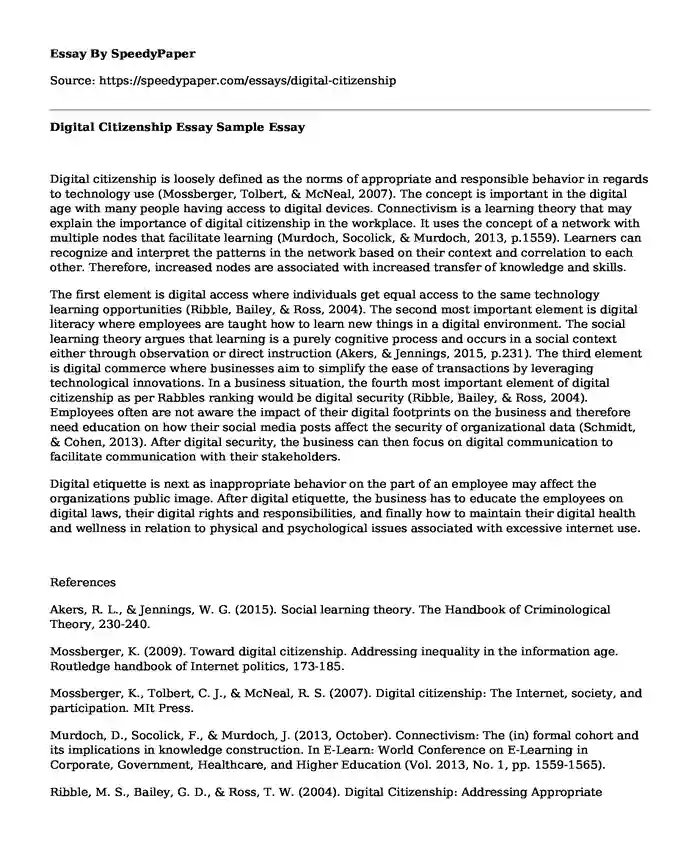Digital citizenship is loosely defined as the norms of appropriate and responsible behavior in regards to technology use (Mossberger, Tolbert, & McNeal, 2007). The concept is important in the digital age with many people having access to digital devices. Connectivism is a learning theory that may explain the importance of digital citizenship in the workplace. It uses the concept of a network with multiple nodes that facilitate learning (Murdoch, Socolick, & Murdoch, 2013, p.1559). Learners can recognize and interpret the patterns in the network based on their context and correlation to each other. Therefore, increased nodes are associated with increased transfer of knowledge and skills.
The first element is digital access where individuals get equal access to the same technology learning opportunities (Ribble, Bailey, & Ross, 2004). The second most important element is digital literacy where employees are taught how to learn new things in a digital environment. The social learning theory argues that learning is a purely cognitive process and occurs in a social context either through observation or direct instruction (Akers, & Jennings, 2015, p.231). The third element is digital commerce where businesses aim to simplify the ease of transactions by leveraging technological innovations. In a business situation, the fourth most important element of digital citizenship as per Rabbles ranking would be digital security (Ribble, Bailey, & Ross, 2004). Employees often are not aware the impact of their digital footprints on the business and therefore need education on how their social media posts affect the security of organizational data (Schmidt, & Cohen, 2013). After digital security, the business can then focus on digital communication to facilitate communication with their stakeholders.
Digital etiquette is next as inappropriate behavior on the part of an employee may affect the organizations public image. After digital etiquette, the business has to educate the employees on digital laws, their digital rights and responsibilities, and finally how to maintain their digital health and wellness in relation to physical and psychological issues associated with excessive internet use.
References
Akers, R. L., & Jennings, W. G. (2015). Social learning theory. The Handbook of Criminological Theory, 230-240.
Mossberger, K. (2009). Toward digital citizenship. Addressing inequality in the information age. Routledge handbook of Internet politics, 173-185.
Mossberger, K., Tolbert, C. J., & McNeal, R. S. (2007). Digital citizenship: The Internet, society, and participation. MIt Press.
Murdoch, D., Socolick, F., & Murdoch, J. (2013, October). Connectivism: The (in) formal cohort and its implications in knowledge construction. In E-Learn: World Conference on E-Learning in Corporate, Government, Healthcare, and Higher Education (Vol. 2013, No. 1, pp. 1559-1565).
Ribble, M. S., Bailey, G. D., & Ross, T. W. (2004). Digital Citizenship: Addressing Appropriate Technology Behavior. Learning & Leading with Technology, 32(1), 6.
Schmidt, E., & Cohen, J. (2013). The new digital age: Reshaping the future of people, nations and business. Hachette UK.
Cite this page
Digital Citizenship Essay Sample. (2019, Sep 26). Retrieved from https://speedypaper.net/essays/digital-citizenship
Request Removal
If you are the original author of this essay and no longer wish to have it published on the SpeedyPaper website, please click below to request its removal:
Popular categories





